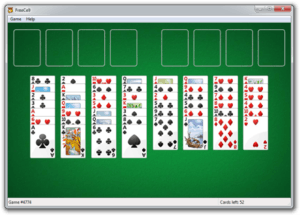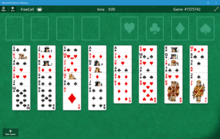Microsoft FreeCell
| A component of Microsoft Windows | |
|---|---|
|
| |
 FreeCell on Windows 7 | |
| Details | |
| Type | Computer game |
| Included with | Windows 95 up to Windows 7 |
| Replaced by | Microsoft Solitaire Collection (Windows 10) |
| Related components | |
| Hearts, Solitaire, Spider Solitaire | |
FreeCell, also known as Microsoft FreeCell,[1] is a computer game included in Microsoft Windows,[2] based on a card game with the same name.
Development
The first computer version of the game is believed to have been created by Paul Alfille in 1978 for the PLATO system. Microsoft developer Jim Horne, who learned the game from the PLATO system, implemented a version with color graphics for Windows. It was first included in Microsoft Entertainment Pack Volume 2 and later the Best Of Microsoft Entertainment Pack.[3] It was subsequently included with Win32s as an application that enabled the testing of the 32-bit thunking layer to ensure that it was installed properly.[4] However, FreeCell remained relatively obscure until it was released as part of Windows 95.[5] In Windows XP, FreeCell was extended to support a total of 1 million card deals.[3]
Releases

Today, there are FreeCell implementations for nearly every modern operating system as it is one of the few games pre-installed with every copy of Windows. Prior to Windows Vista, the versions for Windows were limited in their player assistance features, such as retraction of moves. The Windows Vista FreeCell implementation contains basic hints and unlimited move retraction (via the Undo menu choice or command),[6] and the option to restart the game. Some features have been removed, such as the flashing screen to warn the player of one move remaining. FreeCell is not included in the Windows 8 operating system but is available in the Windows Store as the free Microsoft Solitaire Collection, which is also bundled with Windows 10.
Legacy
The original Microsoft FreeCell package supports 32,000 numbered deals, generated by a 15-bit, pseudorandom-number seed. These deals are known as the "Microsoft 32,000",[3] and all but one of them have been completed.[5] Later versions of FreeCell include more than one million deals.[3] When Microsoft FreeCell became very popular during the 1990s, the Internet FreeCell Project attempted to solve all the deals by crowdsourcing consecutive games to specific people. The project ran from August 1994 to April 1995, and only #11982 proved unwinnable.[7] Out of the current Microsoft Windows games, eight are unsolvable.[8][9]
The significance of the "Microsoft 32,000" to many FreeCell players is such that other computer implementations of FreeCell will often go out of their way to guarantee compatibility with these deals, rather than simply using the most readily available random number generator for their target platforms.[3][10]
References
- ↑ "FreeCell Stops Responding When You Click Undo". Support. Microsoft. 2007-01-23. Archived from the original on 2007-02-06. Retrieved 2017-01-20.
- ↑ Rubenking, Neil J. (March 4, 1997). "User-to-User". PC Magazine. p. 271. Retrieved January 20, 2017.
- 1 2 3 4 5 Keller, Michael (2005). "FreeCell - Frequently Asked Questions (FAQ)". Solitaire Laboratory. Retrieved January 20, 2017.
- ↑ "How to Troubleshoot Win32s Installation Problems". Microsoft. 1998-05-21. Archived from the original on 2010-07-12. Retrieved 2010-07-12.
- 1 2 Kaye, Ellen (2002-10-17). "One Down, 31,999 to Go: Surrendering to a Solitary Obsession". New York Times. Retrieved 2017-01-20.
- ↑ Rubenking, Neil J. (January 2008). "Ask Neil". PC Magazine. p. 124. Retrieved 12 June 2012.
- ↑ O'Reilly, Tim; Mott, Troy; Glenn, Walter J. (1999-09-02). Windows 98 in a Nutshell. O'Reilly Media, Inc. pp. 199–. ISBN 9781565924864. Retrieved 12 June 2012.
- ↑ Leonhard, Woody (2009-09-15). Windows 7 All-In-One for Dummies. John Wiley & Sons. pp. 293–. ISBN 9780470487631. Retrieved 12 June 2012.
- ↑ "FreeCell lists of difficult (and extra easy) deals". Solitaire Laboratory. March 13, 2010. Retrieved February 7, 2018.
- ↑ "PySol - Rules for Freecell". PySolFC documentation. Retrieved 3 February 2018.